MMDetection——2021广东工业智造创新大赛
MMdetection 智能算法赛:瓷砖表面瑕疵质检
目前正在参加一个Tianchi数据竞赛比赛链接 数据下载,是有关于AI深度学习的目标检测,经过了一系列的混沌,在参加比赛的第十二天终于有资格提交成绩了。虽然比起大佬来真的是望其项背,但是作为一位学统计的,首次接触AI,能有成绩已经很欣慰了。

下面是整个流程记录,以便以后再接触有关目标检测的数据竞赛的时候能够有个参照,另一方面也和大家分享分享。
文章目录
- MMdetection 智能算法赛:瓷砖表面瑕疵质检
- 一、赛题背景
- 二、赛题数据说明
-
- 1.数据说明
- 2.标注说明
- 3.类别说明
- 4.提交说明
- 三、切图处理
-
- 1.voc格式数据
- 2.coco格式数据集生成
- 四、MMdetection工具箱的训练
- 五、导出json结果文件
- 总结
一、赛题背景
佛山作为国内最大的瓷砖生产制造基地之一,拥有众多瓷砖厂家和品牌。经前期调研,瓷砖生产环节一般(不同类型砖工艺不一样,这里以抛釉砖为例)经过原材料混合研磨、脱水、压胚、喷墨印花、淋釉、烧制、抛光,最后进行质量检测和包装。得益于产业自动化的发展,目前生产环节已基本实现无人化。而质量检测环节仍大量依赖人工完成。一般来说,一条产线需要配2~6名质检工,长时间在高光下观察瓷砖表面寻找瑕疵。这样导致质检效率低下、质检质量层次不齐且成本居高不下。瓷砖表检是瓷砖行业生产和质量管理的重要环节,也是困扰行业多年的技术瓶颈。
本赛场聚焦瓷砖表面瑕疵智能检测,要求选手开发出高效可靠的计算机视觉算法,提升瓷砖表面瑕疵质检的效果和效率,降低对大量人工的依赖。要求算法尽可能快与准确的给出瓷砖疵点具体的位置和类别,主要考察疵点的定位和分类能力。
二、赛题数据说明
1.数据说明
大赛深入到佛山瓷砖知名企业,在产线上架设专业拍摄设备,实地采集生产过程真实数据,解决企业真实的痛点需求。大赛数据覆盖到了瓷砖产线所有常见瑕疵,包括粉团、角裂、滴釉、断墨、滴墨、B孔、落脏、边裂、缺角、砖渣、白边等。实拍图示例如下:
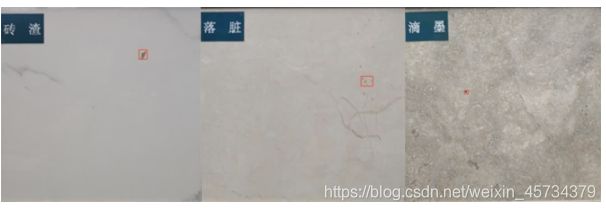
针对某些缺陷在特定视角下的才能拍摄到,每块砖拍摄了三张图,包括低角度光照黑白图、高角度光照黑白图、彩色图,示例如下:

2.标注说明
训练标注是train_annos.json,内容如下:
[
{
"name": "226_46_t20201125133518273_CAM1.jpg",
"image_height": 6000,
"image_width": 8192,
"category": 4,
"bbox": [
1587,
4900,
1594,
4909
]
},
'''
'''
]
3.类别说明
id和瑕疵名的对应关系如下:
{
"0": "背景",
"1": "边异常",
"2": "角异常",
"3": "白色点瑕疵",
"4": "浅色块瑕疵",
"5": "深色点块瑕疵",
"6": "光圈瑕疵"
}
4.提交说明
参赛者需要提供一份json文件包含所有预测结果,文件内容如下:
[
{
"name": "226_46_t20201125133518273_CAM1.jpg",
"category": 4,
"bbox": [
5662,
2489,
5671,
2497
],
"score": 0.130577
},
{
"name": "226_46_t20201125133518273_CAM1.jpg",
"category": 2,
"bbox": [
6643,
5416,
6713,
5444
],
"score": 0.120612
},
...
...
{
"name": "230_118_t20201126144204721_CAM2.jpg",
"category": 5,
"bbox": [
3543,
3875,
3554,
3889
],
"score": 0.160216
}
]
三、切图处理
分析图片得出以下结论:
1.瑕疵太小,并且小目标居多,下图是一个例子:

2.图像分片率大(下载数据就10多G)
3.部分标注不明,且有包含关系的框
因此考虑切块处理,但是这里不太建议遍历全图去切,因为这样会带来很多正常的样本,滑窗切块也是会引入大量背景的,这样的训练样本是没有太大意义的。这里根据bbox为中心进行切块(窗口为1333,考虑MMdetection默认image_scale()是1333),也就是将一块砖的每个瑕疵找到并进行切块处理,最终得到13327张照片。
1.voc格式数据
代码如下(这边感谢大佬调包先生uncleT的support):
import json
from xml.etree import ElementTree as ET
import cv2
import math
img_paths = 'F:\\TTTianchi\\tile_round1_train_20201231\\train_imgs\\'#相关路径
rawLabelDir='F:\\TTTianchi\\tile_round1_train_20201231\\train_annos.json'
with open(rawLabelDir) as f:#打开json文件
image_meta =json.load(f,encoding='utf-8')
each_img_meta = {
}
for each_item in image_meta:
each_img_meta[each_item['name']] = []
for idx, each_item in enumerate(image_meta):
bbox = each_item['bbox']
bbox.append(each_item['category'])
each_img_meta[each_item['name']].append(bbox)
# 创建xml文件的函数
def create_tree(image_name, h, w):
global annotation
# 创建树根annotation
annotation = ET.Element('annotation')
# 创建一级分支folder
folder = ET.SubElement(annotation, 'folder')
# 添加folder标签内容
folder.text = None
# 创建一级分支filename
filename = ET.SubElement(annotation, 'filename')
filename.text = image_name
# 创建一级分支source
source = ET.SubElement(annotation, 'source')
# 创建source下的二级分支database
database = ET.SubElement(source, 'database')
database.text = 'Unknown'
# 创建一级分支size
size = ET.SubElement(annotation, 'size')
# 创建size下的二级分支图像的宽、高及depth
width = ET.SubElement(size, 'width')
width.text = str(w)
height = ET.SubElement(size, 'height')
height.text = str(h)
depth = ET.SubElement(size, 'depth')
depth.text = '3'
# 创建一级分支segmented
segmented = ET.SubElement(annotation, 'segmented')
segmented.text = '0'
# 定义一个创建一级分支object的函数
def create_object(root, xi, yi, xa, ya, obj_name): # 参数依次,树根,xmin,ymin,xmax,ymax
# 创建一级分支object
_object = ET.SubElement(root, 'object')
# 创建二级分支
name = ET.SubElement(_object, 'name')
# print(obj_name)
name.text = str(obj_name)
pose = ET.SubElement(_object, 'pose')
pose.text = 'Unspecified'
truncated = ET.SubElement(_object, 'truncated')
truncated.text = '0'
difficult = ET.SubElement(_object, 'difficult')
difficult.text = '0'
# # 创建bndbox
bndbox = ET.SubElement(_object, 'bndbox')
xmin = ET.SubElement(bndbox, 'xmin')
xmin.text = '%s' % xi
ymin = ET.SubElement(bndbox, 'ymin')
ymin.text = '%s' % yi
xmax = ET.SubElement(bndbox, 'xmax')
xmax.text = '%s' % xa
ymax = ET.SubElement(bndbox, 'ymax')
ymax.text = '%s' % ya
#=====================================================================
import os
import random
#手动建立
#os.makedirs('F:/TTTianchi/bb/segment/voc/JPEGImages', exist_ok=True)
#os.makedirs('F:/TTTianchi/bb/segment/voc/Annotations', exist_ok=True)
window_s = 1333
for idx, each_item in enumerate(image_meta):
print(each_item)
bbox = each_item['bbox']
img = cv2.imread(img_paths + each_item['name'])
# h, w = img.shape[:2]
h=img.shape[0]
w=img.shape[1]
# each_img_meta[each_item['name']].append(bbox)
center_x, center_y = int(bbox[0] + (bbox[2] - bbox[0]) / 2), int((bbox[3] - bbox[1]) / 2 + bbox[1])
x, y, r, b = center_x - window_s // 2, center_y - window_s // 2, center_x + window_s // 2, center_y + window_s // 2
x = x - random.randint(50, 100)
y = y - random.randint(50, 100)
x = max(0, x)
y = max(0, y)
r = min(r, w)
b = min(b, h)
boxes = each_img_meta[each_item['name']]
annotations = []
for e_box in boxes:
if x < e_box[0] < r and y < e_box[1] < b and x < e_box[2] < r and y < e_box[3] < b:
e_box1 = [int(i) for i in e_box]
e_box1[0] = math.floor(e_box1[0] - x)
e_box1[1] = math.floor(e_box1[1] - y)
e_box1[2] = math.ceil(e_box1[2] - x)
e_box1[3] = math.ceil(e_box1[3] - y)
annotations.append(e_box1)
each_img_meta[each_item['name']].remove(e_box)
print('process id:', idx, "|", annotations)
if annotations:
slice_img = img[y:b, x:r]
create_tree(each_item['name'], window_s, window_s)
for anno in annotations:
create_object(annotation, anno[0], anno[1], anno[2], anno[3], anno[4])
tree = ET.ElementTree(annotation)
slice_name = each_item['name'][:-4] + '_' + str(x) + '_' + str(y) + '.jpg'
xml_name = each_item['name'][:-4] + '_' + str(x) + '_' + str(y) + '.xml'
cv2.imwrite('F:/TTTianchi/bb/segment/voc/JPEGImages/' + slice_name, slice_img)
tree.write('F:/TTTianchi/bb/segment/voc/Annotations/' + xml_name)
else:
continue
if x < 0 or y < 0 or r > w or b > h:
print(idx)
print(each_item['name'])
这边就是用自己的笔记本电脑运行的,差不多1个多小时就可以出来一个voc文件夹,里面包含着两个文件夹JPEGImage(存放切割好的图片)和Annotations(对应的xml文件)。
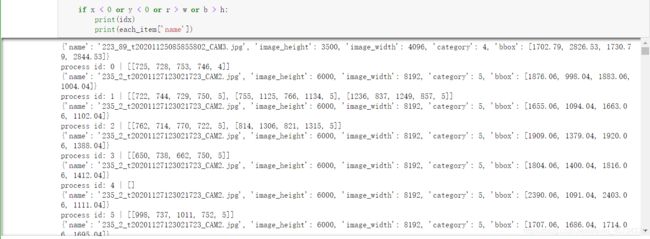
2.coco格式数据集生成
import sys
import os
import shutil
import numpy as np
import json
import xml.etree.ElementTree as ET
import mmcv
# 检测框的ID起始值
START_BOUNDING_BOX_ID = 1
# 类别列表无必要预先创建,程序中会根据所有图像中包含的ID来创建并更新
PRE_DEFINE_CATEGORIES ={
"1":1,#边异常
"2":2,#角异常
"3":3,#白色点瑕疵
"4":4,#浅色块瑕疵
"5":5,#深色点块瑕疵
"6":6#光圈瑕疵
}
def get(root, name):
vars = root.findall(name)
return vars
def get_and_check(root, name, length):
vars = root.findall(name)
if len(vars) == 0:
raise NotImplementedError('Can not find %s in %s.'%(name, root.tag))
if length > 0 and len(vars) != length:
raise NotImplementedError('The size of %s is supposed to be %d, but is %d.'%(name, length, len(vars)))
if length == 1:
vars = vars[0]#取第一个东西
return vars
def convert(xml_list, xml_dir, json_file):
'''
:param xml_list: 需要转换的XML文件列表
:param xml_dir: XML的存储文件夹
:param json_file: 导出json文件的路径
:return: None
'''
list_fp = xml_list
image_id=1
# 标注基本结构
json_dict = {
"images":[],
"categories": [],
"annotations": []}
categories = PRE_DEFINE_CATEGORIES
bnd_id = START_BOUNDING_BOX_ID
for line in list_fp:
line = line.strip()
#print(" Processing {}".format(line))
#Processing 235_2_t20201127123021723_CAM2_2469_4657.xml
# 解析XML
xml_f = os.path.join(xml_dir, line)
tree = ET.parse(xml_f)
root = tree.getroot()
# filename = root.find('filename').text
filename='{}'.format(line)
filename=filename[:-4]+'.jpg'
#print(filename)
# 取出图片名字
image_id+=1
size = get_and_check(root, 'size', 1)
# 图片的基本信息
width = int(get_and_check(size, 'width', 1).text)
height = int(get_and_check(size, 'height', 1).text)
image = {
'height': height,
'width': width,
'id':image_id,#计数
'file_name': filename}
#del image['file_name']
#print(image)
#=============================
json_dict['images'].append(image)
#================================
# 处理每个标注的检测框
for obj in get(root, 'object'):
# 取出检测框类别名称
category = get_and_check(obj, 'name', 1).text
# 更新类别ID字典
if category not in categories:
new_id = len(categories)
categories[category] = new_id
category_id = categories[category]
bndbox = get_and_check(obj, 'bndbox', 1)
xmin = int(get_and_check(bndbox, 'xmin', 1).text) - 1
ymin = int(get_and_check(bndbox, 'ymin', 1).text) - 1
xmax = int(get_and_check(bndbox, 'xmax', 1).text)
ymax = int(get_and_check(bndbox, 'ymax', 1).text)
assert(xmax > xmin)
assert(ymax > ymin)
o_width = abs(xmax - xmin)
o_height = abs(ymax - ymin)
annotation = dict()
# 设置分割数据,点的顺序为逆时针方向
annotation['segmentation'] = [[xmin,ymin,xmin,ymax,xmax,ymax,xmax,ymin]]
annotation['iscrowd'] = 0
annotation['image_id'] = image_id
annotation['bbox'] = [xmin, ymin, o_width, o_height]
annotation['area'] = o_width*o_height
annotation['category_id'] = category_id
annotation['id'] = bnd_id
#annotation['ignore'] = 0
json_dict['annotations'].append(annotation)
bnd_id = bnd_id + 1
# 写入类别ID字典
for cate, cid in categories.items():
cat = {
'supercategory': 'none', 'id': cid, 'name': cate}
json_dict['categories'].append(cat)
# 导出到json
#mmcv.dump(json_dict, json_file)
#print(type(json_dict))
#print(json_dict)
json_data = json.dumps(json_dict)
with open(json_file, 'w') as w:
w.write(json_data)
if __name__ == '__main__':
root_path = 'F:/TTTianchi/bb/segment/'
if not os.path.exists(os.path.join(root_path,'coco/annotations')):
os.makedirs(os.path.join(root_path,'coco/annotations'))
if not os.path.exists(os.path.join(root_path, 'coco/train2017')):
os.makedirs(os.path.join(root_path, 'coco/train2017'))
if not os.path.exists(os.path.join(root_path, 'coco/val2017')):
os.makedirs(os.path.join(root_path, 'coco/val2017'))
xml_dir = os.path.join(root_path,'voc/Annotations') #已知的voc的标注
xml_labels = os.listdir(xml_dir)
#print(xml_labels) #总共有六个
np.random.shuffle(xml_labels)#打乱顺序了·
#split_point = int(len(xml_labels)/3)
split_point=4000#自定义val(验证集)里面有4000个样本量
# validation data
xml_list = xml_labels[0:split_point]
json_file = os.path.join(root_path,'coco/annotations/instances_val2017.json')
convert(xml_list, xml_dir, json_file)
for xml_file in xml_list:
img_name = xml_file[0:-4] + '.jpg'
print(img_name)
shutil.copy(os.path.join(root_path, 'voc/JPEGImages/', img_name),
os.path.join(root_path, 'coco/val2017/', img_name))
## train data
xml_list = xml_labels[split_point:]
json_file = os.path.join(root_path,'coco/annotations/instances_train2017.json')
convert(xml_list, xml_dir, json_file)
for xml_file in xml_list:
img_name = xml_file[0:-4] + '.jpg'
shutil.copy(os.path.join(root_path, 'voc/JPEGImages/', img_name),
os.path.join(root_path, 'coco/train2017/', img_name))
这里也是用笔记本电脑的jupyter notebook编译运行的,运行时间大概40分钟。这里提供网盘的coco格式的数据(大约3.5G)coco数据集 提取码:li6n 。
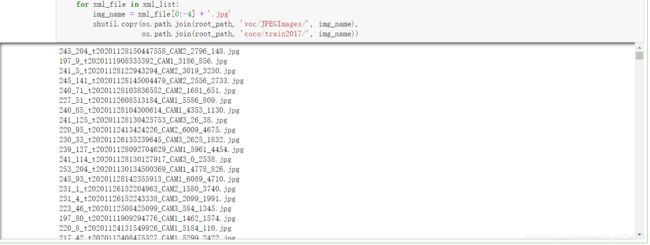
四、MMdetection工具箱的训练
这里具体内容不多赘述,因为仅仅涉及到最简单的调用函数问题,具体可以参照我的另一篇文章MMDetection目标检测实例,首次尝试的模型是faster-rcnn。
因为训练时间特别长,第一次我仅仅迭代了2次(大约40分钟),最后的结果如下图:
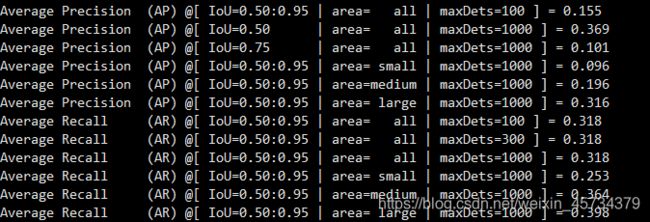
通过单个图片的演示,绿色的框显示是“5,0.4”,也就是检测出该瑕疵有0.4的score是深色点块瑕疵,但是从图中可以看出还有其他很明显的深色点块瑕疵,但是demo的话只会画出score大于0.4阈值的框:
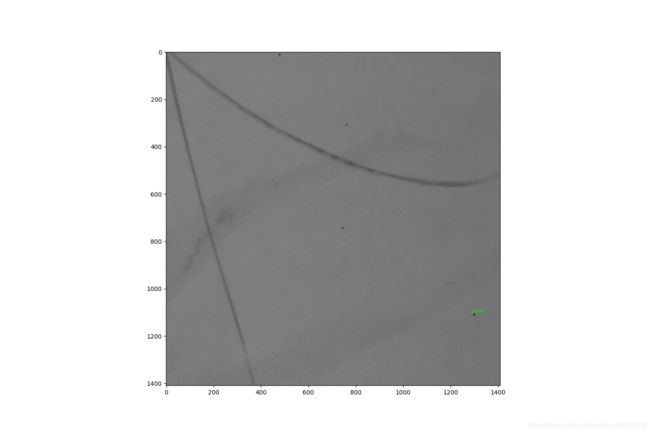
五、导出json结果文件
导出json结果文件代码如下(感谢我爱计算机视觉公众号粉丝 sloan, jianh的分享):
import time
import os
import json
import mmcv
from mmdet.apis import inference_detector, init_detector, show_result_pyplot
def main():
config_file = 'configs/faster_rcnn/faster_rcnn_r50_fpn_1x_coco.py' #
checkpoint_file = 'checkpoints/epoch_2.pth' #通过python tools/train.py configs/faster_rcnn/faster_rcnn_r50_fpn_1x_coco.py得出的epoch_2.pth
test_path = 'data/coco/test/tile_round1_testA_20201231/testA_imgs' #test的图片所在的路径下
json_name = "result_" + "" + time.strftime("%Y%m%d%H%M%S", time.localtime()) + ".json"
model = init_detector(config_file, checkpoint_file, device='cuda:0')
img_list = []
for img_name in os.listdir(test_path):
if img_name.endswith('.jpg'):
img_list.append(img_name)
result = []
for i, img_name in enumerate(img_list, 1):
full_img = os.path.join(test_path, img_name)
predict = inference_detector(model, full_img)
for i, bboxes in enumerate(predict, 1):
if len(bboxes) > 0:
defect_label = i
print(i)
image_name = img_name
for bbox in bboxes:
x1, y1, x2, y2, score = bbox.tolist()
x1, y1, x2, y2 = round(x1, 0), round(y1, 0), round(x2, 0), round(y2, 0) # 没有小数点
#if score > 0.2:#只有score大于0.2才写入json文件
result.append(
{
'name': image_name, 'category': defect_label, 'bbox': [x1, y1, x2, y2], 'score': score})
with open(json_name, 'w') as fp:
json.dump(result, fp, indent=4, separators=(',', ': '))
if __name__ == "__main__":
main()
针对上图,得出的json文件为:
[
{
"name": "m.jpg",
"category": 5,
"bbox": [
1293.0,
1099.0,
1310.0,
1118.0
],
"score": 0.4027006924152374
},
{
"name": "m.jpg",
"category": 5,
"bbox": [
738.0,
736.0,
754.0,
751.0
],
"score": 0.2009522020816803
},
{
"name": "m.jpg",
"category": 5,
"bbox": [
756.0,
300.0,
772.0,
315.0
],
"score": 0.19962109625339508
},
{
"name": "m.jpg",
"category": 5,
"bbox": [
472.0,
5.0,
487.0,
19.0
],
"score": 0.16872453689575195
},
{
"name": "m.jpg",
"category": 5,
"bbox": [
460.0,
550.0,
475.0,
565.0
],
"score": 0.06814242899417877
}
]
总结
要是有更好的方法会更新,下面有两个想法:
1.增加FASTERRCNN的迭代次数。
2.根据我爱计算机视觉公众号粉丝 sloan, jianh的分享来尝试CascadeRCNN。